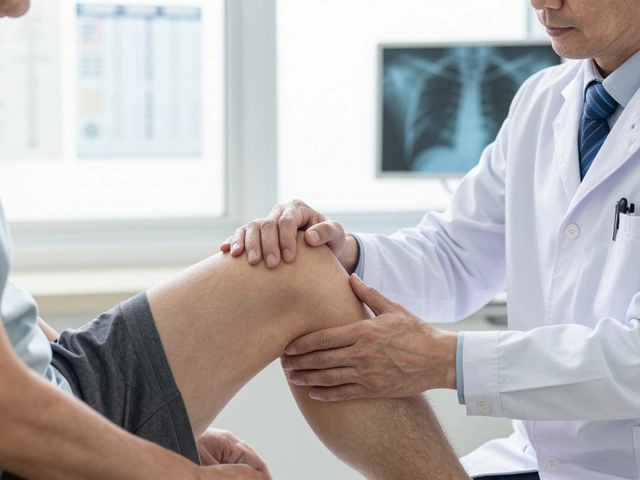Breaking a bone is never an easy experience; it's painful, disruptive, and often comes with a long recovery period. The human body is a complex structure of many bones, each playing a crucial role in our day-to-day movements. But when these bones break, they vary in terms of the pain they cause, and some are known to be particularly excruciating.
Among the numerous bones we have, certain ones like the femur, ribs, or even tiny ones in hands can lead to overwhelming pain if fractured. An intricate balance of factors tips the scales of pain when it comes to broken bones. From the density of nerve endings surrounding the bone to how integral the bone is to movement, each contributes to the level of discomfort experienced.
This piece delves into the most notoriously painful breaks and explains what makes them so agonizing. Understanding these differences not only sheds light on the nature of these injuries but also helps in preparing for them, should misfortune strike, with useful strategies for managing pain and aiding recovery.
- Introduction to Bone Fractures
- Identifying the Most Painful Bone to Break
- Factors Influencing Pain Severity in Fractures
- Common Painful Fractures and Their Symptoms
- Recovery Tips and Pain Management for Bone Breaks
Introduction to Bone Fractures
Bone fractures, a common result of accidents, falls, or sports injuries, represent a significant concern within the realm of orthopedic injuries. The human skeleton, composed of 206 bones, supports and structures the body while simultaneously protecting vital organs. These bones, strong and resilient, can nonetheless succumb to stress or impact beyond their limits, resulting in fractures. Such injuries not only inflict physical pain but also demand a comprehensive understanding for effective treatment and recovery.
The way a bone breaks can vary widely, depending on many factors like the angle of the impact, the force involved, and the health of the bone at the time of injury. Common types of bone fractures include simple, compound, transverse, oblique, comminuted, and greenstick fractures. Each type is distinct not just in appearance and complexity, but also in treatment protocols and healing duration. A painful bone break like a compound fracture, where the bone pierces the skin, typically demands immediate medical intervention due to the heightened risk of infection.
"A fracture is not just a break in the bone; it represents a challenge in terms of healing and functionality," notes renowned orthopedic surgeon Dr. John Richards.
The severity of a fracture correlates with its specific location and associated damage to surrounding tissue. For instance, breaks in load-bearing bones such as the femur or pelvis often involve significant pain and longer recovery times. The severity can also be influenced by the age and overall health of the individual, with older adults facing added challenges due to osteoporosis or other bone-weakening conditions. With orthopedic injuries being prevalent, understanding the mechanics and repercussions of bone fractures is crucial for athletes, the elderly, and anyone engaged in physical activities.
| Type of Fracture | Description |
|---|---|
| Simple Fracture | A bone break that doesn't penetrate the skin |
| Compound Fracture | The bone breaks and pierces through the skin |
| Comminuted Fracture | Bone shatters into several pieces |
| Greenstick Fracture | Occurs mainly in children where the bone bends and partially breaks |
Recognizing the intricacies of bone fractures is the first step toward effective management. Education on the different types of breaks, as well as understanding the pain involved, arms patients and caregivers with knowledge that can facilitate better responses to these injuries. In this section, we will continue to examine how these factors come together, influencing both the immediate pain and the long-term healing process.
Identifying the Most Painful Bone to Break
When it comes to identifying the most painful bone break, the femur, also known as the thigh bone, is often cited as being one of the most excruciating. This isn’t merely because of its size and strength but also due to the substantial muscle mass surrounding it that can spasm and contract violently after a fracture, increasing the agony. The femur's central role in bearing our body weight also means any movement or pressure can exacerbate pain, making even the slightest adjustment intolerable. This can be a harrowing ordeal, as many who have experienced femur fractures can attest.
Equally debilitating in its agony is a rib fracture. These slender bones protect our vital organs, and any damage to them poses a risk beyond intense pain. Breathing, a usually unconscious process, becomes a painful task as each movement of the rib cage can send searing pain throughout the torso. Doctors often observe that patients suffering from rib fractures are challenged deeply as simple acts like laughing, coughing, or even talking can cause sharp discomfort. This kind of forced immobility can significantly impact one's day-to-day life.
Understanding Pain Complexity in Bone Fractures
The human body contains a network of more than 200 bones, and each break tells its own story. Compounding the situation is how a bone fracture pain can vary widely not only from one person to another but also from one fracture to another. Factors influencing this include the density of nerves around the bone and surrounding tissues. Fractures in areas densely packed with nerve endings, like the fingers or toes, can also harbor intense pain despite their smaller sizes. This pain isn't just physical; the psychological impact of knowing that even minor fractures can interfere severely with one’s life plays a part too.
"There are many variables that can change the level of pain felt with a fracture," says Dr. John Ruano, a leading orthopedic specialist, "from the type of break — clean or compound — to the bone's proximity to major nerves and blood vessels."
Statistics show that certain demographics, particularly older adults who are more prone to osteoporosis, might find hip fractures especially debilitating. Such fractures not only lead to prolonged pain but can significantly impact mobility and independence, contributing to emotional distress. Similarly, children who experience growth plate fractures (areas of growing tissue near the ends of long bones) often endure considerable pain, which can affect their development if not treated properly.
Recognizing Pain Levels and Their Impacts
The level of pain experienced depends on several factors, but certain severe fractures like those mentioned clearly demonstrate how complex and varying the sensation of pain can be. Whether it's the femur, ribs, or smaller bones of the hands and feet, each presents unique challenges. In addressing pain, understanding these differences is crucial, not just for medical professionals but for patients who relate their experiences to broader contexts of injury and recovery.
- Femur: Largest bone, critical for weight support, surrounded by large muscles, significant pain due to tissue damage.
- Ribs: Pain with every breath, risk of puncture to internal organs, multiple breaks can be catastrophic.
- Fingers/Toes: High nerve density leads to sharp pain, affects daily functions despite small size.
- Hip: Common in older adults, long recovery, major impact on lifestyle and independence.
Such insights are invaluable for those who seek to prevent these injuries or find themselves having to cope with the aftermath. Knowing what to expect can prepare individuals to better manage medical care and rehabilitation efforts, ensuring a more informed, comprehensive approach to healing and adapting to life with a fracture.

Factors Influencing Pain Severity in Fractures
When it comes to the excruciating pain associated with bone fractures, several significant factors contribute to the intensity of discomfort a person might feel. First and foremost, the location of the break plays a crucial role. Bones like the femur, which is not only robust but also essential for major movement, tend to cause an immense amount of pain when fractured. This is because such bones are surrounded by a dense network of nerves, and any disruption in their structure sends sharp pain signals to the brain. Similarly, rib fractures are known to be extremely painful due to their role in every breath we take, highlighting the impact of a broken bone's function on the pain experienced.
In addition to the location and function, the nature of the fracture itself matters significantly. Compound fractures, where the bone pierces the skin, create a much more serious situation not just because of potential infection risks, but also due to the additional trauma to the skin and muscles. The severity of these fractures is heightened as they involve damage to surrounding tissues, increasing inflammation and pain intensity.
Age, as well, is a notable factor, with older individuals often experiencing greater pain due to their bones being generally more brittle and prone to fractures. This fragility often leads to more complex breaks, demanding more extensive healing time and, consequently, prolonged discomfort. Contrastingly, younger patients may heal quicker but can still face intense immediate pain due to the same biological mechanisms. The pain experience can also be subjective, varying widely between individuals, where some might tolerate pain better due to genetic factors.
Cleveland Clinic experts emphasize, "The location of a fracture and the types of bones involved can greatly affect pain levels."
Moreover, how quickly and effectively a fracture is treated impacts pain severity. Immediate immobilization and professional medical intervention can reduce the time for which pain is experienced, but delays in treatment can lead to complications like improper bone alignment, which not only exacerbates pain but can lead to chronic issues. Finally, personal pain tolerance, previous pain experiences, and psychological factors such as anxiety about one's recovery can also play influential roles in how severely pain is felt.
The severity of pain following bone fractures is a multifaceted outcome shaped by physical, biological, and psychological elements. Each of these factors interplays to determine how unbearable a broken bone feels, proving the truth in the adage that no two pain experiences are entirely alike. For orthopedic specialists and patients alike, understanding these factors is crucial for providing effective pain management strategies and ensuring optimal recovery paths.
Common Painful Fractures and Their Symptoms
When it comes to breaking a bone, the level of pain often depends on the specific bone affected. Among the myriad of bones within the human body, a few stand out due to the intense discomfort they cause when fractured. Among these, the femur ranks exceptionally high. The femur, or thighbone, is not only the longest but also one of the strongest bones in the body. A femur fracture, resulting from high-impact traumas like car accidents, can be excruciating due to the sheer force needed to cause such an injury. Symptoms often include severe pain, inability to move the leg, swelling, and visible deformities. This type of fracture requires urgent medical attention, often needing surgical intervention to correct and stabilize the bone.
Next on the list are rib fractures, which are notoriously painful and distressing. The ribs protect crucial organs and thus, having one or more broken ribs can impair breathing and cause acute chest pain. With each breath, laugh, or cough, the pain can intensify, creating a challenging experience for the individual. Bruising, swelling, and visible uneven ribcage are telltale signs. Ribs typically heal with ample rest and pain management strategies, but the process can take several weeks to a few months, demanding patience and caution.
Another often underestimated but highly painful fracture is that of the collarbone or clavicle. It's a common injury in sports and accidents involving a fall onto an outstretched arm. The collarbone connects the arm to the body, creating a complex network affected by movement. When fractured, one experiences immediate shoulder pain, difficulty in moving the arm, and visible swelling or bruising near the shoulder. Recovery usually involves wearing a sling and physical therapy to restore full function and mobility, but the pain in the initial days can be quite challenging to manage.
It's important not to overlook vertebral fractures, which can occur due to osteoporosis or traumatic injuries. These fractures affect the spine, the pillar on which our body’s balance and movement depend. The symptoms vary greatly; some people experience intense sharp pain, while others may feel numbness in limbs or difficulty standing upright. This fracture's implications are serious, emphasizing the need for early diagnosis and appropriate treatment to prevent long-term disability. Individuals with osteoporosis are particularly at risk, necessitating proactive measures for bone health maintenance.
As renowned orthopedic surgeon Dr. John R. Cassidy emphasizes, 'Timely intervention can significantly improve outcomes in vertebral fractures, reducing pain and improving functionality.'
Lastly, wrist fractures often occur when people instinctively put their hands out to catch themselves during a fall. Specifically, the distal radius—the large bone on the thumb side of the wrist—is vulnerable. Such fractures are incredibly common, especially among athletes and the elderly. Pain, swelling, bruising around the wrist, and visible deformity are typical symptoms. This type of fracture usually requires immobilization with a cast and sometimes surgery, depending on the severity. The recovery can involve a prolonged phase of physiotherapy, but managing pain from the outset is crucial for an effective treatment journey. Knowing these common fractures and their symptoms can prepare individuals for recognizing and responding promptly to these injuries, potentially easing the bone fracture pain.

Recovery Tips and Pain Management for Bone Breaks
Recovering from a broken bone is a journey that requires time, patience, and careful management. The first step in ensuring a smooth recovery process is understanding the nature of your fracture and tailoring your healing strategy accordingly. Rest is crucial and it's important to avoid putting undue stress on the affected area. Your body needs to focus its energy on healing, and overstressing broken bones can lead to complications and prolonged recovery periods. A well-structured rehabilitation plan is also necessary, often involving the guidance of medical professionals who can offer personalized advice on when and how to gradually reintroduce activity.
Pain management is equally important in the recovery journey. Pain from broken bones can be intense and persistent, but several strategies can help alleviate discomfort. Medications, such as over-the-counter pain relievers like ibuprofen or acetaminophen, are often recommended in the initial stages of a fracture. These medications can help manage inflammation and provide relief from acute pain. In certain cases, doctors might prescribe stronger analgesics, especially for fractures known to be exceptionally painful like the femur or rib injuries.
Physical therapy plays a vital role in rehabilitation, helping individuals regain strength and mobility in the affected area. Regular sessions with a physiotherapist can improve outcomes by enhancing flexibility, reducing stiffness, and preventing further injuries. It's essential to follow a structured program tailored to the specific type of fracture and individual capability. Additionally, maintaining a balanced diet rich in calcium and vitamin D is important to support bone health and recovery. According to the Mayo Clinic, "a well-balanced diet with the appropriate nutrients can have a significant impact on the body's ability to heal".
"Recovery is not just about healing the bone, but also about restoring function and quality of life," says Dr. Sarah Johnson, an orthopedic specialist.
Innovative techniques such as cryotherapy or heat therapy can also be beneficial. These treatments work by helping to reduce swelling and improve circulation in the affected area, which can alleviate pain and promote healing. It's important to discuss with your healthcare provider before starting new treatment methods to ensure they align with your overall recovery strategy. Beyond physical healing, addressing emotional and psychological aspects of recovery can also enhance well-being. Engaging in activities that reduce stress, like meditation or yoga, can be helpful during your healing process.
A commitment to following medical advice and attending all follow-up appointments ensures that the healing process is on track and complications are promptly addressed. Adhering to a well-rounded recovery plan makes a significant difference in recuperation and helps individuals transition back to normal activities with confidence. Remember, each fracture and person is unique, and keeping a positive and informed approach to recovery will help you navigate through this challenging time.





